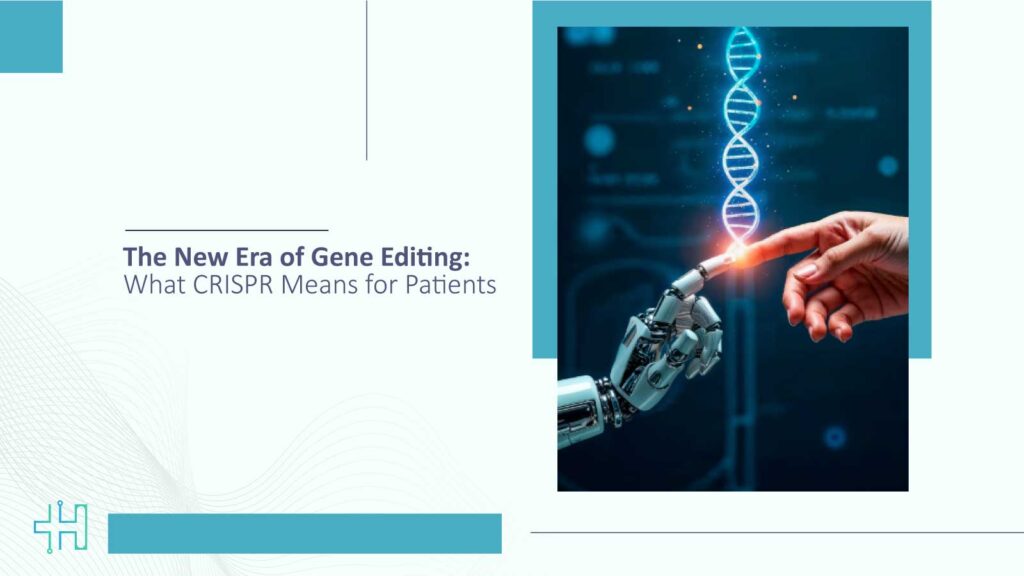The decoding of the human genome was a breakthrough that humans have celebrated. After that experiment, the idea of changing the genetic makeup directly in the human body remained a fantasy for a long time.
As of now, the help of an impressive technology called CRISPR has made it possible to picture the idea coming true. The implication of the device in genetic diseases, cancer, or rare disorders is a new chapter – hoping, understanding the complexity, and evolving.
A Fresh Spark of Hope: Introducing CRISPR
Suppose you had a very long instruction manual on how to make a machine, and there was a typo on one of the pages. That little mistake might cause the whole system to work incorrectly. Now suppose you could open the manual, find the typo, and fix it exactly. This is basically what CRISPR does with our genes.
CRISPR is an acronym for Clustered Regularly Interspaced Short Palindromic Repeats. The “guide RNA” is helping the molecular “scissors” (most frequently the Cas9 enzyme) to locate a particular DNA sequence. At that point, it breaks and enables scientists to remove, insert, or correct genes. The part that makes it the most revolutionary is that it is so programmable – scientists can tailor the system to locate almost any sequence of genetic material they want to.
More than 300 registered clinical trials globally are testing gene editing technologies (including CRISPR and base editing) as of early 2025.
The method is quick, cheap, and accurate. To be exact, researchers say that the CRISPR method brings down the cost of genome editing by 90% in comparison with the previous technologies. Therefore, what used to take years can now be done in a matter of months. This is one of the most attainable and genetic innovations that can be scaled to different populations. But the transition from laboratory trials to safe, effective use in patients is, however, the place where the real difficulty and opportunity are located.
The Challenges We Must Confront
While CRISPR offers enormous promise, it also raises significant hurdles – scientific, ethical, and social.
A. Precision and Safety
The biggest concern is off-target effects – unintended edits that could disrupt other genes and cause harm. Researchers are developing safer enzyme variants, improved guide RNAs, and AI-driven modeling to predict and prevent such errors.
Emerging technologies like base editing and prime editing aim to refine the process further, enabling changes without cutting DNA entirely. These advancements could make CRISPR treatments more predictable and less risky.
B. Delivery Challenges
Even if scientists can edit DNA precisely, getting CRISPR’s components into the right cells remains tricky. Current methods use viral vectors or lipid nanoparticles, each with pros and cons. Viral methods can trigger immune responses, while nanoparticles often struggle to reach deep tissues like the brain.
Researchers are experimenting with next-generation delivery systems – tiny bubbles called extracellular vesicles or programmable RNA carriers – to improve targeting and safety. The ultimate goal is in vivo editing, where CRISPR works directly inside the body without removing and reinfusing cells.
C. Immune Reactions and Long-Term Monitoring
Because CRISPR uses bacterial proteins (like Cas9), the body’s immune system may treat them as invaders. Some trials have reported mild immune reactions, and long-term follow-up is essential to monitor for delayed effects.
Scientists are now exploring humanized enzymes and transient editing systems that disappear after making their change, minimizing exposure and immune risk.
D. Cost and Accessibility
Even successful CRISPR therapies are currently expensive. Casgevy, for example, costs around $2.2 million per patient, making it one of the priciest treatments ever approved. While such therapies are often covered through insurance or special programs, high costs highlight a deeper issue: how to make advanced medicine accessible to everyone who needs it.
As more CRISPR treatments move through clinical trials, industry experts expect costs to fall as manufacturing scales, similar to how genome sequencing prices dropped dramatically over the past decade.
E. Ethics and Regulation
Gene editing brings moral questions to the forefront. Should we edit embryos to prevent disease, or could that open the door to designer genetics? Who decides what counts as therapy versus enhancement?
The U.S. FDA has so far taken a measured approach, approving therapies only for severe, inherited diseases and under strict oversight. Ethicists emphasize transparency and inclusivity, ensuring public dialogue keeps pace with scientific innovation. Responsible innovation means more than technical progress – it’s about trust, informed consent, and fairness.
How Patients Can Engage with This Revolution?
For patients and families facing genetic disorders, CRISPR represents both opportunity and uncertainty. Here’s how to navigate it wisely:
- Talk to your doctor about ongoing CRISPR or gene-editing trials. Many are recruiting in major U.S. research centers.
- Understand the risks and benefits. Early trials are about safety first, not guaranteed cures.
- Join patient advocacy groups. They provide access to resources, updates, and community support.
- Stay informed. Medical knowledge is evolving rapidly – today’s experimental treatment could become tomorrow’s standard care.
The Road Ahead
The next decade will determine how deeply CRISPR transforms medicine. Several trends are already shaping the future:
- In vivo editing becomes reality. Trials are underway to edit genes directly inside the body, starting with liver and eye diseases.
- AI meets gene editing. Artificial intelligence is being used to predict the safest and most effective guide RNA sequences – making CRISPR smarter and more personalized.
- Broader disease coverage. Beyond blood disorders, CRISPR trials are expanding into cardiovascular, neurological, and autoimmune conditions.
- More ethical oversight. As capabilities grow, so will the demand for transparent regulation and equitable access.
A New Chapter in Medicine
CRISPR is not a miracle cure, but it’s the most transformative medical tool of our time. It allows scientists to move from treating symptoms to correcting the underlying causes of disease – an unprecedented shift in modern healthcare.
For patients, that means a future where inherited illnesses may be prevented before birth, cancers could be fought at the genetic level, and rare disorders once deemed incurable might be reversed. But progress must be careful, not reckless. The promise of gene editing can only be fulfilled if safety, ethics, and equality guide the journey.
Handled wisely, CRISPR could redefine what medicine means – not just extending lives, but improving them at the deepest biological level. The story of the next generation of healthcare is being written now, one gene at a time.
FAQs
1. What is CRISPR and how does it work?
CRISPR is a gene-editing technology that allows scientists to make precise changes to DNA. It works like molecular scissors, cutting and replacing faulty genes with healthy ones. This lets doctors potentially fix the root cause of certain diseases rather than just treating symptoms
2. What diseases can CRISPR help treat?
CRISPR has shown success in treating genetic blood disorders such as sickle cell disease and β-thalassemia. Researchers are also testing it for cancer, liver diseases, and rare genetic conditions. In the future, it may be used for heart and neurological disorders as well.
3. Is CRISPR therapy safe?
CRISPR treatments are still relatively new and carefully monitored in clinical trials. Most early results show strong safety and effectiveness, though researchers continue to study long-term effects and potential off-target edits. Safety improvements are advancing rapidly through new versions like base and prime editing.
4. How much does CRISPR treatment cost?
Currently, approved CRISPR therapies such as Casgevy can cost around $2 million per patient. However, these prices are expected to drop as more treatments are approved, manufacturing scales up, and insurance coverage expands.
5. Can CRISPR be used to edit human embryos or enhance traits?
In the U.S., editing embryos for reproduction or enhancement is not allowed. CRISPR is currently used only to treat serious diseases in living patients under strict FDA supervision. Ethical guidelines ensure the technology is used responsibly and not for altering physical traits or abilities.
Keep reading on Health Technology Insights.
To participate in our interviews, please write to our HealthTech Media Room at sudipto@intentamplify.com




